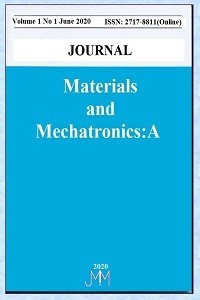MIG-MAG Kaynak Kontak Kılavuzlarında Cu-W Kompozit Sinterlerin Sürekli Tel Aşındırma Performansı için Kullanımı
Toz Metalurjisi, Aşınma Dayanımı, MIG-MAG Kaynak Yöntemi, Kontak Kılavuzları
The Use of Cu-W Sinters in MIG-MAG Welding Contact Tips for Improved Continuous Wire Abrasion Performance
___
- Adam G., Sievert T.A., Quinn T., Vigliotti P., Contact Tube Temperature during GMAW, Welding Journal, 37-41, 2001.
- Chen P., Shen Q., Luo G., Wang C., Li M., Zhang L., Li X., Zhu B., Effect of Interface Modification by Cu Coating W Powders on the Microstructure Evolution and Properties Improvement for Cu-W Composites, Surface and Coatings Technology 288, 8-14, 2016.
- Childs T.H.C., The Sliding Wear Mechanisms of Metals, Mainly Steels, Tribology International 13(6), 285-293, 1980.
- Deshpande P.K., Lin R.Y., Wear Resistance of WC Particle Reinforced Copper Matrix Composites and the Effect of Porosity, Materials Science and Engineering: A 418(1-2), 137-145, 2006.
- Deuis R.L., Subramanian C., Yellup J.M., Dry Sliding Wear of Aluminium Composites – A Review, Composite Science Technology 57(4), 415-435, 1997.
- Dhokey N.B., Paretkar R.K., Study of Wear Mechanisms in Copper-Based SiCp (20% by volume) Reinforced Composite, Wear 265(1–2), 117-133, 2008.
- Donghua D., Dongdong G., Thermal Behavior and Densification Mechanism during Selective Laser Melting of Copper Matrix Composites: Simulation and Experiments, Materials & Design 55, 482-491, 2014.
- Dube R.K., Maji P., Bikramjit B., Enhancement of Wear Resistance Of Copper with Tungsten Addition (less than 20 wt. %) By Powder Metallurgy Route, Journal of Tribology 131(4), 1-9, 2009.
- Durgutlu, A. and Gülenç, B., The Effect of Welding Speed on the Microstructure and Penetration in Arc Welding, Turkish Journal of Engineering and Environmental Sciences 23(4): 251-260, 1999.
- Ezer M., Cam G., A Study on Microstructure and Mechanical Performance of Gas Metal Arc Welded AISI 304L Joints, Material Science and Engineering Technology 53(9): 1043-1052, 2022.
- Gautam R.K., Ray S., Jain S.C., Sharma S.C., Tribological Behavior of Cu–Cr–SiCP in-situ Composite, Wear 265(5-6), 902-912, 2008.
- Jamwal A., Mittal P., Agrawal R., Gupta S., Kumar D., Sadasivuni K.K., Gupta P., Towards Sustainable Copper Matrix Composites: Manufacturing Routes with Structural, Mechanical, Electrical and Corrosion Behaviour, Journal of Composite Materials 54(19), 2635-2649, 2020.
- Kou S., Welding Metallurgy, Wiley International, Second Edition, 2002.
- Lancaster J.F., The Physics of Welding, Pergamon Press, Second Edition, Oxford, pp. 204–234, 1986.
- Ma G.C., Fan J.L., Gong H.R., Mechanical Behavior of Cu-W Interface Systems Upon Tensile Loading from Molecular Dynamics Simulations, Computational Materials Science 152, 165-168, 2018.
- Selvakumar N., Vettivel S.C., Thermal, Electrical and Wear Behavior of Sintered Cu–W Nanocomposite, Materials and Design 46, 16-25, 2013.
- Serindag H.T., Cam G., Multi-pass butt welding of thick AISI 316L plates by gas tungsten arc welding: Microstructural and mechanical characterization, International Journal of Pressure Vessels and Piping, 200, 104842, 2022.
- Serindag H.T., Tardu C., Kircicek I.O, Cam G., A study on microstructural and mechanical properties of gas tungsten arc welded thick cryogenic 9% Ni alloy steel butt joint, CIRP Journal of Manufacturing Science and Technology, 37, 1-10, 2022.
- Shimizu H., Yokota Y., Mizuno M., Kurokawa T., Wear Mechanism in Contact Tube, Science and Technology of Welding and Joining 11(1), 94-105, 2006.
- Singla M., Singh L., Chawla V., Study of Wear Properties of Al–SiC Composites, Journal of Minerals Materials Characterization and Engineering 8(10), 813-819, 2009.
- Tjong S.C., Lau K.C., Abrasive Wear Behaviour of TiB2 Particle Reinforced Copper Matrix Composites, Materials Science and Engineering: A 282(1-2), 183-186, 2000.
- Yazar M., Kul M., Alp A.K., Talaş Ş., The use of NiAl Coating Deposited by ESD against the Wear of Sliding Wire in GMAW Contact Tips, Journal of Polytechnic 25(2), 739-744, 2022.
- Zhang L., He X.B., Qu X.H., Duan B.H., Lu X., Qin M.L., Dry Sliding Wear Properties of High Volume Fraction SiCp/Cu Composites Produced by Pressure Less Infiltration, Wear 265 (11-12), 1848-1856, 2008.
- Zou J., Song D., Shi H., Liang S., Effects of Grading Tungsten Powders on Properties of CuW Alloy, Materials Research Express 7(2): 026528, 2020.
- Yayın Aralığı: Yılda 2 Sayı
- Başlangıç: 2020
- Yayıncı: Yusuf KAYALI
Umit TAYFUN, Çağrıalp ARSLAN, Mehmet DOĞAN
Isıl İşlemin Bakır Kaplı Çelik Boruların Mekanik Özelliklerine Etkisinin Araştırılması
Ozan KOYUNCU, Burak ÇELİK, Yasin AKGÜL, Alper İNCESU
Osman Bahadır ÖZDEN, Barış GÖKÇE, Abdullah ERDEMİR
Zekerya KAYA, Bekir AKSOY, Koray ÖZSOY
Mert Eren AYĞAHOĞLU, Mehmet Sefa GÜMÜŞ, Abdullah ÇAKAN, Mete KALYONCU
İbrahim SAVRUKOĞLU, Kubilay ASLANTAS
Bulanık Mantık Denetleyicisi ile Volan Ters Sarkacın Denge Kontrolü
Hüseyin Oktay ERKOL, Cemil KÖZKURT
Derviş ÖZKAN, Garip ERDOĞAN, Yasin OZGURLUK, Gülfem BİNAL, Sefa Erdem YILMAZ, Abdullah KARAOGLANLİ
Elle Kaldırma Hareketinde Kutu Boyutunun L5/S1 Eklemine Etkisinin İncelenmesi
